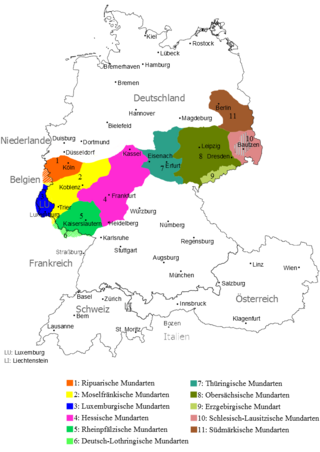Upper Saxon German
This article needs additional citations for verification. (August 2007) |
| Upper Saxon | |
|---|---|
| Obersächsisch | |
| Native to | Germany |
| Region | Saxony |
Native speakers | (2 million cited 1998)[1] |
| Language codes | |
| ISO 639-3 | sxu |
| Glottolog | uppe1465 |
 Central German dialects after 1945 and the expulsions of the Germans
Upper Saxon (8) | |
Upper Saxon (
Standard German has been heavily based on Upper Saxon, especially in its lexicon and grammar. This is due to it being used as the basis for early developments in the standardization of German during the early 1500s, including the translation of the Bible by Martin Luther.[3]
History
Upper Saxon evolved as a new variety in the course of the medieval German Ostsiedlung (eastern colonisation) from about 1100 onwards. Settlers descending from the stem duchies of Saxony, Franconia, and Bavaria, as well as Thuringia and Flanders, moved into the Margravate of Meissen between the Elbe and Saale rivers,[4] formerly populated by Polabian Slavs. As the colonists belonged to different German tribes speaking different dialects, Upper Saxon became an intermediary, koiné dialect (Kolonialdialekt or Ausgleichsdialekt), having less distinct features than the older, more original dialects.[4]
In the
Due to the influence and prestige of the Electorate of Saxony during the Baroque era (17th to 18th century), and especially its role as a focal point of artists and scientists, the language of the Upper Saxon elite (but not of its ordinary people) was considered the exemplary variant of German during that period. The literary theorist
With Saxony's loss of political power after the Seven Years' War (1756–63), its dialect lost prestige as well. In 1783, philosopher Johann Erich Biester, residing in the Prussian capital of Berlin, rated the "unpleasant singsong" and "highly peculiar confusion of b and p, of d and t"—even among upper-class speakers—"very crude".[5]
According to linguist Beat Siebenhaar, Upper Saxon — defined as a cohesive linguistic system with its own, clear rules for pronunciation, word formation and syntax — became largely extinct during the second half of the 19th to early 20th century. This was due to the increased adoption of the standard language among the Saxony populace. Since then, (Upper) Saxon merely refers to a colloquial, regional variety of Standard German and not a dialect in the proper sense.[4][5]
Spoken by leading communists from the
Features
Like many other German languages, Upper Saxon features the unrounding of vowel sounds descended from Middle High German (/ø/, /øː/, /y/, /yː/, and /yə̯/ to /e/, /eː/, /i/, and /iː/). This results in words such as bäse for Standard German böse (wicked) and Biehne for Standard German Bühne (stage). In common with other East Central German varieties is the weakening of consonants, resulting in words such as Kardoffeln for Standard German "Kartoffeln" (potatoes) and Babba for Standard German Papa (dad). Additionally, /ë/ is reduced to /a/, resulting in Standard German Schwester (sister) becoming Schwaster in Upper Saxon.
The most notable distinguishing feature of the dialect is that the letters o and u are pronounced as centralized vowels ([ɞ] and [ɵ], respectively, when short; [ɵː] and [ʉː], respectively, when long). Speakers of other German dialects that do not have these sounds tend to perceive these sounds as being ö [øː] and ü [yː] respectively. For example, they hear [ˈɵːma] 'grandma' as if written Öma (Standard Oma [ˈoːma]). Front rounded vowels are pronounced as non-rounded (ö = [eː], ü = [iː]). Final -er is pronounced [oˤ] (or similarly, depending on the subdialect), which speakers of other German dialects tend to hear as [oː]; e.g. [ˈheːo̯ˤ] 'higher' (Standard [ˈhøːɐ̯] höher) is misheard as if written hä(h)er.[citation needed]
The Upper Saxon varieties outside the Ore Mountains can be easily recognized by the supposed "softening" (lenition) of the voiceless stop consonants /p/, /t/ and /k/. Speakers of other dialects hear these as if they were "b", "d" and "g" respectively. In reality, these are merely non-aspirated versions of the same /p/, /t/ and /k/, a widespread feature among Central German dialects, as opposed to strongly aspirated [pʰ], [tʰ] and [kʰ] in dominant German dialects.
In contrast to neighboring Thuringian, Upper Saxon infinitives end in -en as in Standard German rather than -e .
Subgroups
The degree of
- Meißen dialect, which remained in the former margraviate after the development of the New High German standard variety, spoken from Saxon Switzerland including the Dresdenmetrolect.
- North Upper Saxon dialect with stronger Low German features, spoken in Northern Saxony in and around the city of Leipzig, from Torgau and Eilenburg down to Borna, and in the adjacent territory of Saxony-Anhalt up to the Saale River at Weißenfelsin the west
- Erzgebirgisch, a distinct dialect, is spoken in the villages of the Central Ore Mountains. Until the post-war expulsions it also included the "Northwestern Bohemian" language in the adjacent Sudetenland territories to the south, today part of the Czech Republic.[6][7] It is also found in Lower Saxony in the Upper Harz, to where miners from the Ore Mountains moved in the 16th century (see Mining in the Upper Harz).
See also
References
- ^ Upper Saxon at Ethnologue (18th ed., 2015) (subscription required)
- ^ Siebenhaar, Beat. "Der obersächsische Sprachraum". Leipzig University. Retrieved 2 June 2019.
- ^ Sächsische Hochsprache, Deutsche Welle. Retrieved 10 January 2021. (in German)
- ^ a b c "Ein Leipziger Sprachforscher ist sich sicher: Sächsischer Dialekt weitgehend ausgestorben". Leipziger Internet Zeitung. 17 February 2011. Archived from the original on 26 August 2014.
- ^ a b c d e Siebenhaar, Beat (2011). Matthias Donath; André Thieme (eds.). Der sächsische Dialekt. Sächsische Mythen. Edition Leipzig. pp. 91–99.
- ^ Ludwig Erich Schmitt (editor): Germanische Dialektologie. Franz Steiner, Wiesbaden 1968, p. 143
- ^ "dt.swf". Archived from the original on 2007-06-10. Retrieved 2010-03-27.
External links
- Upper Saxon (Obersächsisch or Meißnisch:) at genealogienetz.de
